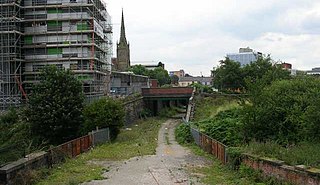
The Beeching cuts, also colloquially referred to as the Beeching Axe, were a major series of route closures and service changes made as part of the restructuring of the nationalised railway system in Great Britain in the 1960s. They are named for Dr. Richard Beeching, then-chair of the British Railways Board and the author of two reports – The Reshaping of British Railways (1963) and The Development of the Major Railway Trunk Routes (1965) – that outlined the necessity of improving the efficiency of the railways and the plan for achieving this through restructuring.

The Varsity Line was the main railway line that linked the English university cities of Oxford and Cambridge, operated by the London and North Western Railway.

Baildon railway station serves the town of Baildon near Shipley in West Yorkshire, England. The station reopened under British Rail on 5 January 1973, by the Chairman of Baildon Council, Arnold Lightowler, having been closed for exactly 20 years. It is situated 4 miles (6 km) north of Bradford Forster Square, on the Wharfedale Line. The station, and all trains serving it, are operated by Northern Trains.

Barassie railway station is a railway station serving Barassie, South Ayrshire, Scotland. The station is managed by ScotRail and is on the Ayrshire Coast Line.

Shirebrook railway station serves the town of Shirebrook in Derbyshire, England. The station is on the Robin Hood Line, 21½ miles (35 km) north of Nottingham towards Worksop.

Caernarvon railway station was a stop on the former Bangor and Carnarvon Railway between Caernarfon in Gwynedd and the Menai Suspension Bridge near Bangor, Wales. The station was closed to all traffic in January 1972; it has since been demolished and the site redeveloped.
The Lanarkshire and Ayrshire Railway (L&AR) was an independent railway company built to provide the Caledonian Railway with a shorter route for mineral traffic from the coalfields of Lanarkshire to Ardrossan Harbour, in Scotland.

Dudley railway station was a railway station in Dudley, Worcestershire, England, built where the Oxford-Worcester-Wolverhampton Line and the South Staffordshire Line diverged to Wolverhampton and Walsall and Lichfield respectively.

Maudland Bridge railway station was once the Preston terminus of the Longridge Branch Line, in Lancashire, England. It was located on Maudland Road, between a bridge over the Lancaster Canal and Cold Bath Street. The Maudlands district of Preston gets its name from the medieval St. Mary Magdalen's leper hospital, which once stood near the present-day St Walburge's Church.

Wisbech East was a railway station in Wisbech, Cambridgeshire. It was opened in 1848 and became part of the Great Eastern Railway network, providing connections to March, Watlington and St Ives, as well as Upwell via the Wisbech and Upwell Tramway. The station closed in 1968 and no trace of it remains today. A freight-only line remains extant as far as a factory based in the station's former goods yard, and a heritage railway based in March is aiming to reinstate services to Wisbech and construct a new station as near as possible to Newbridge Lane crossing.

Aldridge railway station is a former station on the Midland Railway in England. It was opened in 1879, closed in 1965 and subsequently demolished, although the track through the station site is still in use for freight.

Arthington railway station served the village of Arthington in the English county of West Yorkshire, near the North Yorkshire town of Harrogate.
The Oxford, Witney and Fairford Railway was a single track railway branch line, 22 miles (35 km) long, in Oxfordshire and Gloucestershire in England in the United Kingdom. It was opened in succession by two companies, the first in 1861 to connect the important wool-producing town of Witney to the main line network, and the second in 1873 as the rump of an ambitious scheme to connect to Cheltenham, but which ran only between Witney and Fairford. The junction with the main line was at Yarnton, north of Oxford.

Thornton railway station was a station on the Keighley-Queensbury section of the Queensbury Lines which ran between Keighley, Bradford and Halifax via Queensbury. The station served the village of Thornton, West Yorkshire, England from 1878 to 1955.

Butterley railway station is a preserved railway station on the Heritage Midland Railway - Butterley in Derbyshire.
This page is based on this
Wikipedia article Text is available under the
CC BY-SA 4.0 license; additional terms may apply.
Images, videos and audio are available under their respective licenses.












